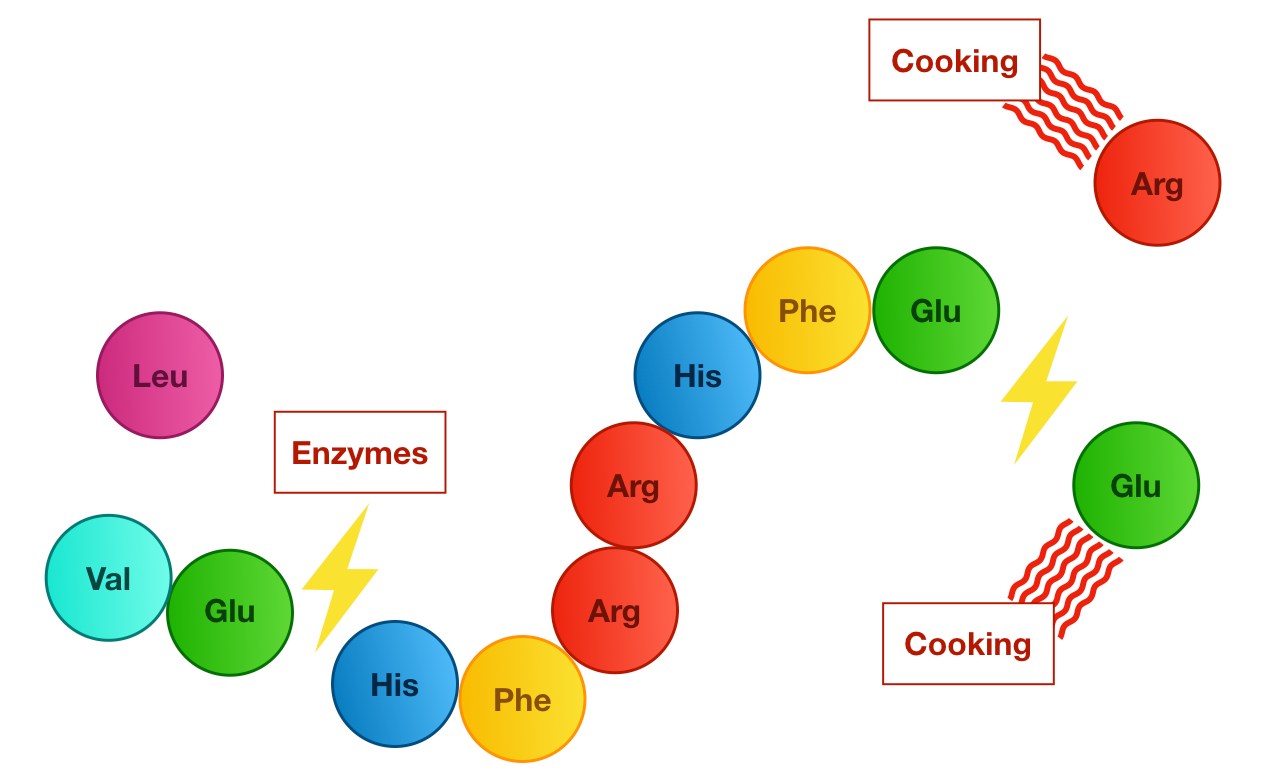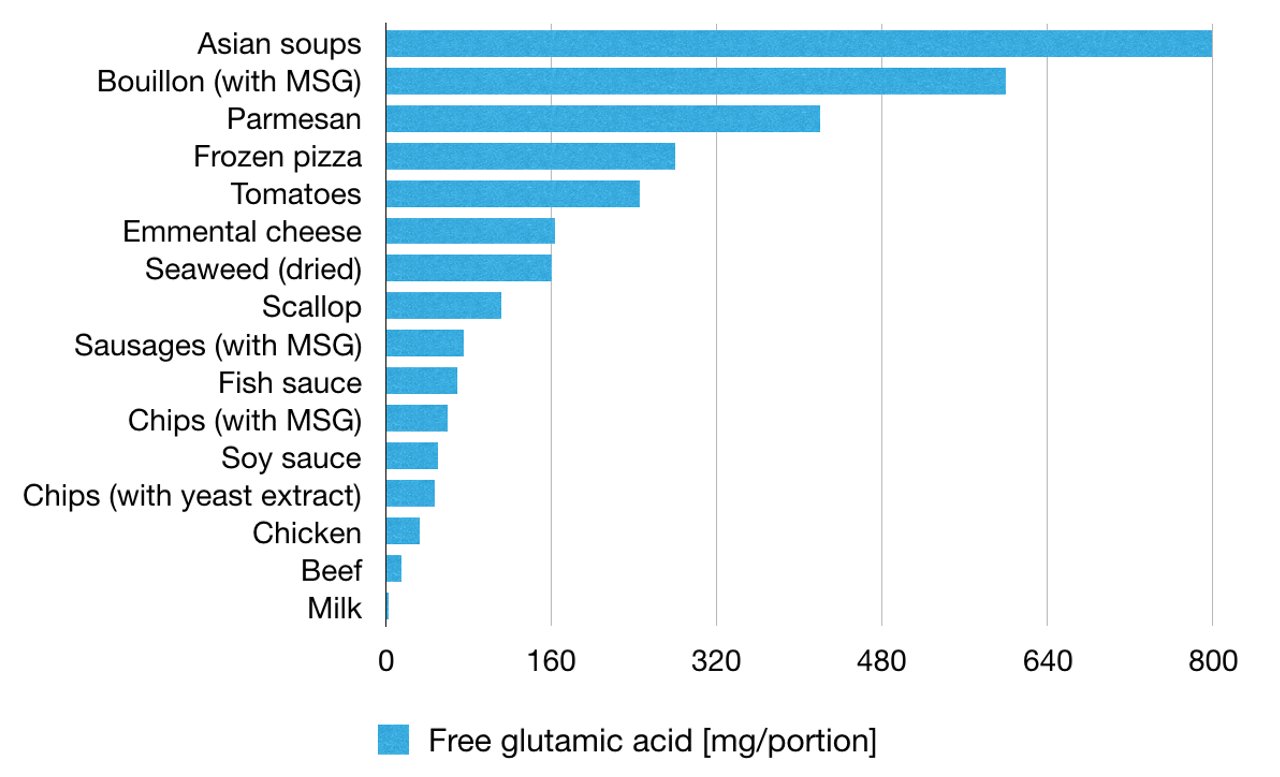Glutamates: Are they really dangerous?
Every food can be turned into a tasty meal, but some seem to have an especially savory flavor that just makes your mouth water. What's their secret?

It's the amino acid L-glutamate (abbreviated as glu) that is responsible for an intense flavor. Its salts are called glutamates. Amino acids are the building blocks for proteins, so all foods with protein contain a certain amount of glu. However, glu only has a flavor enhancing effect when it is extracted from the proteins and occurs in its free form. Foods with a high amount of free L-glutamic acid stimulate certain taste receptors on the tongue and create the so-called umami flavor, which is often compared to the taste of a strong meat broth.
Examples for foods with a high concentration of glu are soy sauce, mature cheeses or tomatoes. Some preparation methods (e. g. prolonged cooking or fermentation) are ideal to convert as much glutamic acid as possible into its free from, thus greatly intensifying the flavor (see figure 1).

▲Figure 1: Proteins are built from long amino acid chains. Each circle represents an amino acid, here “glu” stands for L-glutamic acid. Prolonged cooking or fermentation can liberate the glu from the chain and activate its flavor-enhancing effect.
Some sauces (e. g. soy sauce or similar wheat-based sauces) are widely used to improve the flavor of products. Soy and wheat contain a high concentration of L-glutamic acid, which is separated from the proteins through a fermentation process. As a consequence, these sauces have a high level of glutamates and are often used as a natural flavor enhancer (especially in the Asian cuisine).
If there is no natural occurrence of glutamates, foods can also be enhanced by using additives. L-glutamic acid and its salts are labeled with the E numbers E 620 – E 625. Out of those, monosodium glutamate (E 621), the glutamic acid’s most simple salt, is used most frequently. The food industry is well aware that we can’t easily resist products containing glutamate, and takes advantage of this fact by enriching its products with flavor enhancers. This makes many people eat bigger portions than they mean to, which in turn increases the risk of overweight. Another danger is that you get used to flavor enhancers very quickly – products without them rapidly start to seem boring and tasteless, so we begin to prefer the enhanced variant.
The food industry also profits from another aspect of flavor enhancers: Their products taste better without them having to use quality ingredients, which saves them money.
From a purely chemical point of view, glutamates in additives are no different from natural glutamates: The body metabolizes both the same way. However, artificially enhanced foods (e. g. Asian soups) often contain a significantly higher glutamate concentration (see figure 2).

▲Figure 2: Typical glutamate content per serving in different products.
The usage of flavor enhancers is becoming more and more frowned upon, and many people would like to avoid them. In high concentrations, glutamates can be harmful to animals as well as humans. This is why limits that are considered as safe according to the latest research have been implemented for the use of glutamate in foods. But doubts about the harmlessness remain, since many studies point to possible side effects on humans and animals.
People sensitive to glutamate may experience headaches, stomach aches, asthma, feelings of numbness or weakness, nettle rash or other infectious skin reactions after the consumption. These symptoms are sometimes summarized under the name “Chinese restaurant syndrome” – although historically this term was mainly introduced with the intention of harming the operators of the restaurants.
However, the number of people actually affected is relatively low and it is still unclear whether these reactions are even caused by glutamate itself or possibly by other substances like histamine and other biogenic amines.
Regular food inspections have shown that especially in Asian restaurants the allowed total amount of glutamate is often exceeded, since they commonly use monosodium glutamate – unfortunately often according to the motto “the more, the better”. In 2012, the Bavarian Health and Food Safety Authority found that around 10% of sampled soups exceeded the approved limits. In addition, the ingredients were often not declared sufficiently.
Not only does the insufficient declaration of products containing glutamate make the life of affected people harder, what makes matters even more difficult is that some manufacturers have started to substitute monosodium glutamate with other ingredients that don’t need to be explicitly identified as flavor enhancers:
These ingredients can be hidden sources of glutamate (see figure 3). During the production process the glutamate is enzymatically extracted from the protein-rich source (e. g. yeast), which leads to a high concentration. But since officially these are natural ingredients, substances like yeast extract may also be used in organic products, where the use of glutamate is actually forbidden.

▲Figure 3: Typical ingredient list of processed foods with hidden sources of glutamate.
Some manufacturers even go so far as to promote these products as containing no flavor enhancers. In the US, there are efforts underway so that products need to be labeled as containing glutamate. There is no such obligation in Europe. This is why it’s important to always carefully study the ingredient list and watch out for corresponding entries.
In short: It’s almost impossible to reach the legally set limits for the daily intake of glutamate with natural foods. The biggest risk for an “overdose” lies in Asian restaurants, where glutamate is a standard ingredient. Sensitive people should proceed with care and ask for their meal to be prepared without glutamate. However, even in that case it will probably contain glutamates, since they are already present in high doses in the used soy or fish sauces. Glutamate is also often found in the stock for soups in other restaurants, so it makes sense to be careful with those as well.
Back to blog

It's the amino acid L-glutamate (abbreviated as glu) that is responsible for an intense flavor. Its salts are called glutamates. Amino acids are the building blocks for proteins, so all foods with protein contain a certain amount of glu. However, glu only has a flavor enhancing effect when it is extracted from the proteins and occurs in its free form. Foods with a high amount of free L-glutamic acid stimulate certain taste receptors on the tongue and create the so-called umami flavor, which is often compared to the taste of a strong meat broth.
Examples for foods with a high concentration of glu are soy sauce, mature cheeses or tomatoes. Some preparation methods (e. g. prolonged cooking or fermentation) are ideal to convert as much glutamic acid as possible into its free from, thus greatly intensifying the flavor (see figure 1).

▲Figure 1: Proteins are built from long amino acid chains. Each circle represents an amino acid, here “glu” stands for L-glutamic acid. Prolonged cooking or fermentation can liberate the glu from the chain and activate its flavor-enhancing effect.
Usage of flavor enhancers
Some sauces (e. g. soy sauce or similar wheat-based sauces) are widely used to improve the flavor of products. Soy and wheat contain a high concentration of L-glutamic acid, which is separated from the proteins through a fermentation process. As a consequence, these sauces have a high level of glutamates and are often used as a natural flavor enhancer (especially in the Asian cuisine).
If there is no natural occurrence of glutamates, foods can also be enhanced by using additives. L-glutamic acid and its salts are labeled with the E numbers E 620 – E 625. Out of those, monosodium glutamate (E 621), the glutamic acid’s most simple salt, is used most frequently. The food industry is well aware that we can’t easily resist products containing glutamate, and takes advantage of this fact by enriching its products with flavor enhancers. This makes many people eat bigger portions than they mean to, which in turn increases the risk of overweight. Another danger is that you get used to flavor enhancers very quickly – products without them rapidly start to seem boring and tasteless, so we begin to prefer the enhanced variant.
The food industry also profits from another aspect of flavor enhancers: Their products taste better without them having to use quality ingredients, which saves them money.
From a purely chemical point of view, glutamates in additives are no different from natural glutamates: The body metabolizes both the same way. However, artificially enhanced foods (e. g. Asian soups) often contain a significantly higher glutamate concentration (see figure 2).

▲Figure 2: Typical glutamate content per serving in different products.
Possible side effects of glutamates
The usage of flavor enhancers is becoming more and more frowned upon, and many people would like to avoid them. In high concentrations, glutamates can be harmful to animals as well as humans. This is why limits that are considered as safe according to the latest research have been implemented for the use of glutamate in foods. But doubts about the harmlessness remain, since many studies point to possible side effects on humans and animals.
People sensitive to glutamate may experience headaches, stomach aches, asthma, feelings of numbness or weakness, nettle rash or other infectious skin reactions after the consumption. These symptoms are sometimes summarized under the name “Chinese restaurant syndrome” – although historically this term was mainly introduced with the intention of harming the operators of the restaurants.
However, the number of people actually affected is relatively low and it is still unclear whether these reactions are even caused by glutamate itself or possibly by other substances like histamine and other biogenic amines.
Regular food inspections have shown that especially in Asian restaurants the allowed total amount of glutamate is often exceeded, since they commonly use monosodium glutamate – unfortunately often according to the motto “the more, the better”. In 2012, the Bavarian Health and Food Safety Authority found that around 10% of sampled soups exceeded the approved limits. In addition, the ingredients were often not declared sufficiently.
Hidden sources of glutamate
Not only does the insufficient declaration of products containing glutamate make the life of affected people harder, what makes matters even more difficult is that some manufacturers have started to substitute monosodium glutamate with other ingredients that don’t need to be explicitly identified as flavor enhancers:
- yeast extracts
- autolysed yeast
- hydrolysed proteins
- broth
- spices or seasoning
- tomato powder
- meat extract
- soy seasoning
- soy sauce powder
- fermented wheat
- flavoring
These ingredients can be hidden sources of glutamate (see figure 3). During the production process the glutamate is enzymatically extracted from the protein-rich source (e. g. yeast), which leads to a high concentration. But since officially these are natural ingredients, substances like yeast extract may also be used in organic products, where the use of glutamate is actually forbidden.

▲Figure 3: Typical ingredient list of processed foods with hidden sources of glutamate.
Some manufacturers even go so far as to promote these products as containing no flavor enhancers. In the US, there are efforts underway so that products need to be labeled as containing glutamate. There is no such obligation in Europe. This is why it’s important to always carefully study the ingredient list and watch out for corresponding entries.
Summary
In short: It’s almost impossible to reach the legally set limits for the daily intake of glutamate with natural foods. The biggest risk for an “overdose” lies in Asian restaurants, where glutamate is a standard ingredient. Sensitive people should proceed with care and ask for their meal to be prepared without glutamate. However, even in that case it will probably contain glutamates, since they are already present in high doses in the used soy or fish sauces. Glutamate is also often found in the stock for soups in other restaurants, so it makes sense to be careful with those as well.
Why do we care so much about this topic?
 We have been developing our price-winning "Food Intolerances" app since 2011 and we are happy to share our knowledge with you. Check it out:
We have been developing our price-winning "Food Intolerances" app since 2011 and we are happy to share our knowledge with you. Check it out:
Share article
Share article
Back to blog
![[Blog]](../../rw_common/images/baliza_logo_retina.png)

